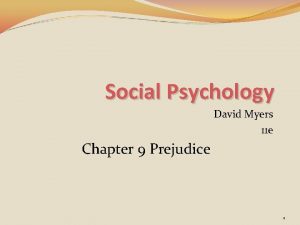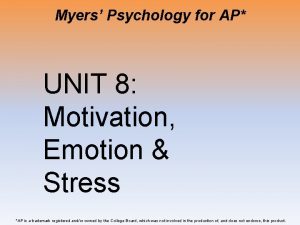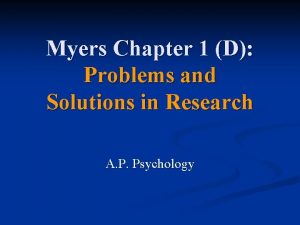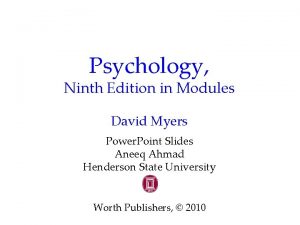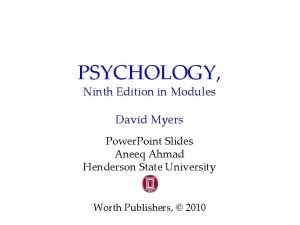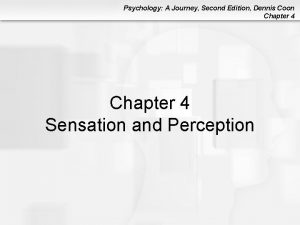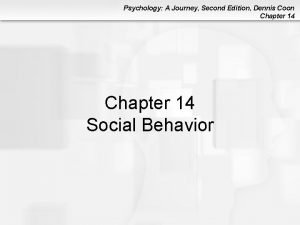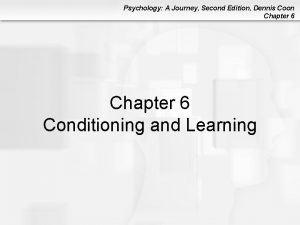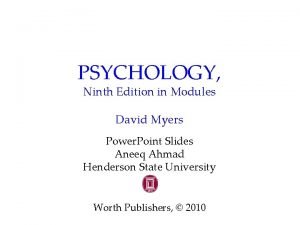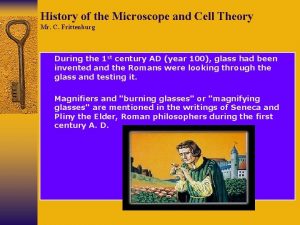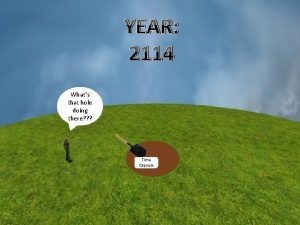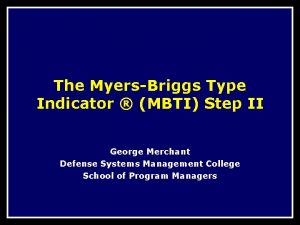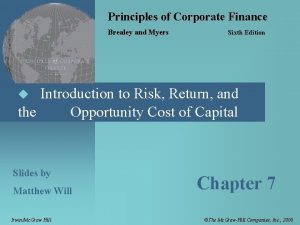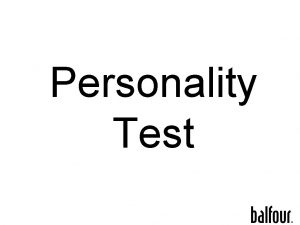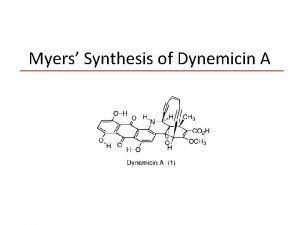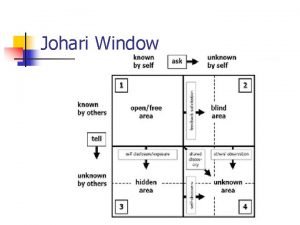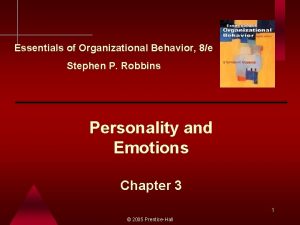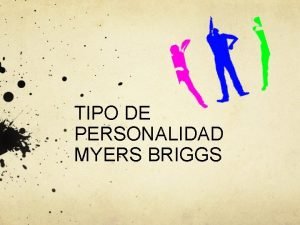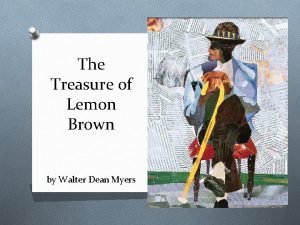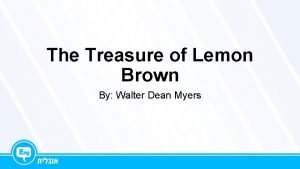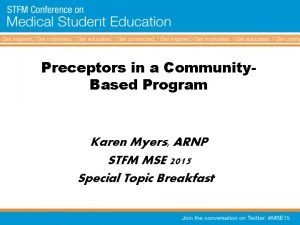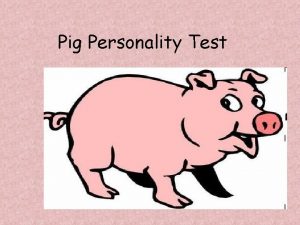PSYCHOLOGY 8 th Edition David Myers Power Point


























































- Slides: 58

PSYCHOLOGY (8 th Edition) David Myers Power. Point Slides Aneeq Ahmad Henderson State University Worth Publishers, © 2006 1

Perception Chapter 6 2

Perception Selective Attention Perceptual Illusions Perceptual Organization § Form Perception § Motion Perception § Perceptual Constancy 3

Perception Perceptual Interpretation § Sensory Deprivation and Restored Vision § Perceptual Adaptation § Perceptual Set § Perception and Human Factor 4

Perception Is there Extrasensory Perception? § Claims of ESP § Premonitions or Pretensions § Putting ESP to Experimental Test 5

Bell Ringer – How many squares do you see? 6

What does this say? Th. Ec. Owg. Avec. Ola Why is it so difficult to read? 7

Perception The process of selecting, organizing, and interpreting sensory information, which enables us to recognize meaningful objects and events. 8

Selective Attention Perceptions about objects change from moment to moment. We can perceive different forms of the Necker cube; however, we can only pay attention to one aspect of the object at a time. Necker Cube 9

Inattentional Blindness • http: //www. youtube. com/watch? v=v. JG 698 U 2 Mvo • http: //www. youtube. com/watch? v=Ut. Kt 8 Y F 7 dg. Q 10

Inattentional Blindness Daniel Simons, University of Illinois Inattentional blindness refers to the inability to see an object or a person in our midst. Simmons & Chabris (1999) showed that half of the observers failed to see the gorillasuited assistant in a ball passing game. 11

Change Blindness • http: //www. youtube. com/watch? v=BZ 0 l 9 s 8 _Hmk • http: //www. youtube. com/watch? v=ub. NF 9 QNEQLA 12

Change Blindness Change blindness is a form of inattentional blindness in which twothirds of individuals giving directions failed to notice a change in the individual asking for directions. © 1998 Psychonomic Society Inc. Image provided courtesy of Daniel J. Simmons. 13

Perceptual Illusions provide good examples in understanding how perception is organized. Studying faulty perception is as important as studying other perceptual phenomena. Line AB is longer than line BC. 14

1. . The bottom line appears longer because of the outward tips but the lines are the same length. 15

St. Louis Arch – Is it taller or wider? Rick Friedman/ Black Star In this picture, the vertical dimension of the arch looks longer than the horizontal dimension. However, both are equal. 16

Can we be prompted to perceive something? • If I tell you something taste bad, do you think you will taste the bad flavor even though I might be lying? • If I tell you to look for something particular, will you see it even if it isn’t there? • If I tell you to listen for a certain phrase/sound, do you think you will hear it even though it might not be there? Some of these are illusions, others are using 17 the Gestalt Principles.

Illusion of a Worm © 1981, by permission of Christoph Redies and Lothar Spillmann and Pion Limited, London The figure on the right gives the illusion of a blue hazy “worm” when it is nothing else but blue lines identical to the figure on the left. 18

3 -D Illusion Reprinted with kind permission of Elsevier Science-NL. Adapted from Hoffman, D. & Richards, W. Parts of recognition. Cognition, 63, 29 -78 It takes a great deal of effort to perceive this figure in two dimensions. 19

3 -D Sidewalk Art 20

21

Backmasking • Are there messages recorded on songs that can be heard when played backwards? • Do people here these messages and then act out certain behaviors? • Rock band Judas Priest was sued when some of their fans committed/attempted suicide after listening to their music – Claimed that the music told them to “do it” and “commit suicide” - Case was thrown out http: //jeffmilner. com/backmasking/ 22

Perceptual Organization When vision competes with our other senses, vision usually wins – a phenomena called visual capture. How do we form meaningful perceptions from sensory information? We organize it. Gestalt psychologists showed that a figure formed a “whole” different than its surroundings. All the individual components form a whole. 23

Examples of Gestalt 24

25

26

27

Form Perception Organization of the visual field into objects (figures) that stand out from their surroundings (ground). Time Savings Suggestion, © 2003 Roger Sheperd. 28

Grouping After distinguishing the figure from the ground, our perception needs to organize the figure into a meaningful form using grouping rules. 29

Grouping & Reality Although grouping principles usually help us construct reality, they may occasionally lead us astray. Both photos by Walter Wick. Reprinted from GAMES Magazine. . © 1983 PCS Games Limited Partnership 30

Depth Perception Innervisions Depth perception enables us to judge distances. Gibson and Walk (1960) suggested that human infants (crawling age) have depth perception. Even newborn animals show depth perception. http: //www. youtube. com/watch? v=p 6 cq. Nh. Hr. MJA Visual Cliff 31

Binocular Cues Retinal disparity: Images from the two eyes differ. Try looking at your two index fingers when pointing them towards each other half an inch apart and about 5 inches directly in front of your eyes. You will see a “finger sausage” as shown in the inset. 32

Binocular Cues Convergence: Neuromuscular cues. When two eyes move inward (towards the nose) to see near objects and outward (away from the nose) to see faraway objects. 33

Monocular Cues Relative Size: If two objects are similar in size, we perceive the one that casts a smaller retinal image to be farther away. 34

Monocular Cues Interposition: Objects that occlude (block) other objects tend to be perceived as closer. Rene Magritte, The Blank Signature, oil on canvas, National Gallery of Art, Washington. Collection of Mr. and Mrs. Paul Mellon. Photo by Richard Carafelli. 35

Monocular Cues Relative Clarity: Because light from distant objects passes through more light than closer objects, we perceive hazy objects to be farther away than those objects that appear sharp and clear. 36

Monocular Cues Texture Gradient: Indistinct (fine) texture signals an increasing distance. © Eric Lessing/ Art Resource, NY 37

Monocular Cues Relative Height: We perceive objects that are higher in our field of vision to be farther away than those that are lower. Image courtesy of Shaun P. Vecera, Ph. D. , adapted from stimuli that appered in Vecrera et al. , 2002 38

Monocular Cues Relative motion: Objects closer to a fixation point move faster and in opposing direction to those objects that are farther away from a fixation point, moving slower and in the same direction. 39

Monocular Cues Linear Perspective: Parallel lines, such as railroad tracks, appear to converge in the distance. The more the lines converge, the greater their perceived distance. © The New Yorker Collection, 2002, Jack Ziegler from cartoonbank. com. All rights reserved. 40

Monocular Cues Light and Shadow: Nearby objects reflect more light into our eyes than more distant objects. Given two identical objects, the dimmer one appears to be farther away. From “Perceiving Shape From Shading” by Vilayaur S. Ramachandran. © 1988 by Scientific American, Inc. All rights reserved. 41

Motion Perception: Objects traveling towards us grow in size and those moving away shrink in size. The same is true when the observer moves to or from an object. 42

Apparent Motion Phi Phenomenon: When lights flash at a certain speed they tend to present illusions of motion. Neon signs use this principle to create motion perception. Two lights after the Illusion other. of motion. One light jumping from flashing one pointone to another: 43

Perceptual (Shape) Constancy Perceiving objects as unchanging even as illumination and retinal images change. Perceptual constancies include constancies of shape and size. Shape Constancy 44

Size Constancy Stable size perception amid changing size of the stimuli. Size Constancy 45

Size-Distance Relationship The distant monster (below, left) and the top red bar (below, right) appear bigger because of distance cues. Alan Choisnet/ The Image Bank From Shepard, 1990 46

Size-Distance Relationship Both girls in the room are of similar height. However, we perceive them to be of different heights as they stand in the two corners of the room. Both photos from S. Schwartzenberg/ The Exploratorium 47

Ames Room The Ames room is designed to demonstrate the sizedistance illusion. 48

Sensory Deprivation – if you are deprived of a stimulus, when you are exposed to that stimulus, you become overloaded Kittens raised without exposure to horizontal lines later had difficulty perceiving horizontal bars. Blakemore & Cooper (1970) 49

Perceptual Adaptation Courtesy of Hubert Dolezal Visual ability to adjust to an artificially displaced visual field, e. g. , prism glasses. 50

Perceptual Set A mental predisposition to perceive one thing and not another. What you see in the center picture is influenced by flanking pictures. From Shepard, 1990. 51

Perceptual Set Other examples of perceptual set. Dick Ruhl Frank Searle, photo Adams/ Corbis-Sygma (a) Loch ness monster or a tree trunk; (b) Flying saucers or clouds? 52

Perception & Human Factors Human Factor Psychologists design machines that assist our natural perceptions. Courtesy of General Electric Photodisc/ Punchstock The knobs for the stove burners on the right are easier to understand than those on the left. 53

Is There Extrasensory Perception? Perception without sensory input is called extrasensory perception (ESP). A large percentage of scientists do not believe in ESP. 54

Claims of ESP Paranormal phenomena include astrological predictions, psychic healing, communication with the dead, and out-of-body experiences, but most relevant are telepathy, clairvoyance, and precognition. 55

Claims of ESP 1. Telepathy: Mind-to-mind communication. One person sending thoughts and the other receiving them. 2. Clairvoyance: Perception of remote events, such as sensing a friend’s house on fire. 3. Precognition: Perceiving future events, such as a political leader’s death. 56

Premonitions or Pretensions? Can psychics see the future? Can psychics aid police in identifying locations of dead bodies? What about psychic predictions of the famous Nostradamus? The answers to these questions are NO! Nostradamus’ predictions are “retrofitted” to events that took place after his predictions. 57

Putting ESP to Experimental Test In an experiment with 28, 000 individuals, Wiseman attempted to prove whether or not one can psychically influence or predict a coin toss. People were able to correctly influence or predict a coin toss 49. 8% of the time. 58
 Psychology ninth edition david g myers
Psychology ninth edition david g myers Psychology eighth edition david g myers
Psychology eighth edition david g myers Reuptake psychology
Reuptake psychology Psychology ninth edition david g myers
Psychology ninth edition david g myers Psychology tenth edition david g myers
Psychology tenth edition david g myers Self-perpetuating prejudgments
Self-perpetuating prejudgments Myers ap psychology unit 8
Myers ap psychology unit 8 Tutored human enrichment
Tutored human enrichment Myers' psychology for ap solutions
Myers' psychology for ap solutions Psychology in everyday life myers
Psychology in everyday life myers Myers' psychology for ap
Myers' psychology for ap Real power and reactive power
Real power and reactive power Informsu
Informsu Point point power
Point point power Mis chapter 6
Mis chapter 6 Report
Report Organic chemistry david klein 3rd edition
Organic chemistry david klein 3rd edition David klein organic chemistry 3rd edition
David klein organic chemistry 3rd edition Organic chemistry (3rd) edition chapter 1 problem 20s
Organic chemistry (3rd) edition chapter 1 problem 20s Organic chemistry third edition david klein
Organic chemistry third edition david klein Klein
Klein Levels of analysis psychology
Levels of analysis psychology Appraisals in lazarus theory of emotion
Appraisals in lazarus theory of emotion Abnormal child psychology 6th edition
Abnormal child psychology 6th edition Fundamentals of abnormal psychology ninth edition
Fundamentals of abnormal psychology ninth edition Social psychology ninth edition
Social psychology ninth edition Psychology
Psychology Psychology a journey 4th edition chapter 1
Psychology a journey 4th edition chapter 1 Psychology a journey 4th edition chapter 1
Psychology a journey 4th edition chapter 1 Psychology a journey 4th edition chapter 1
Psychology a journey 4th edition chapter 1 Psychology ninth edition in modules
Psychology ninth edition in modules Advanced word power second edition answers
Advanced word power second edition answers Statistics: unlocking the power of data 1st edition
Statistics: unlocking the power of data 1st edition Science power 9 atlantic edition
Science power 9 atlantic edition Walter dean myers poetry
Walter dean myers poetry Bad boy walter dean myers summary
Bad boy walter dean myers summary Bad boy walter dean myers summary
Bad boy walter dean myers summary Mbti step 1
Mbti step 1 Marlon myers
Marlon myers Finance brealey and myers
Finance brealey and myers How to draw pig ears
How to draw pig ears Personality test orange blue green gold
Personality test orange blue green gold Andrew myers chemistry
Andrew myers chemistry Monster vocabulary
Monster vocabulary Monster walter dean myers vocabulary
Monster walter dean myers vocabulary N vs s mbti
N vs s mbti Humanmetrics mbti
Humanmetrics mbti Tony robbins myers briggs
Tony robbins myers briggs Myers hall drexel
Myers hall drexel Bridge to terabithia chapter 1 and 2 questions and answers
Bridge to terabithia chapter 1 and 2 questions and answers 5 voices myers-briggs
5 voices myers-briggs Gruneberg and myers
Gruneberg and myers Bad boy walter dean myers
Bad boy walter dean myers Arquitecto mbti
Arquitecto mbti Treasure of lemon brown
Treasure of lemon brown Who is lemon brown
Who is lemon brown Dr karen myers
Dr karen myers Pig drawing psychology test
Pig drawing psychology test Mbti judging vs perceiving
Mbti judging vs perceiving





